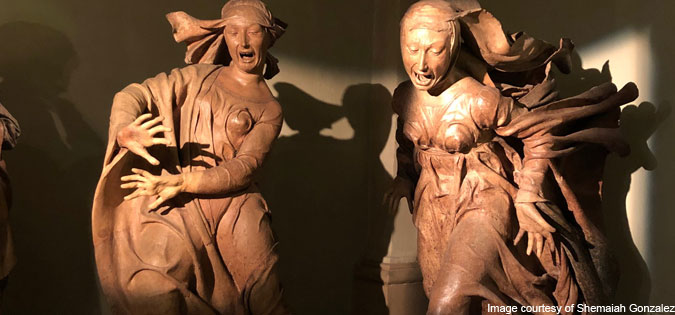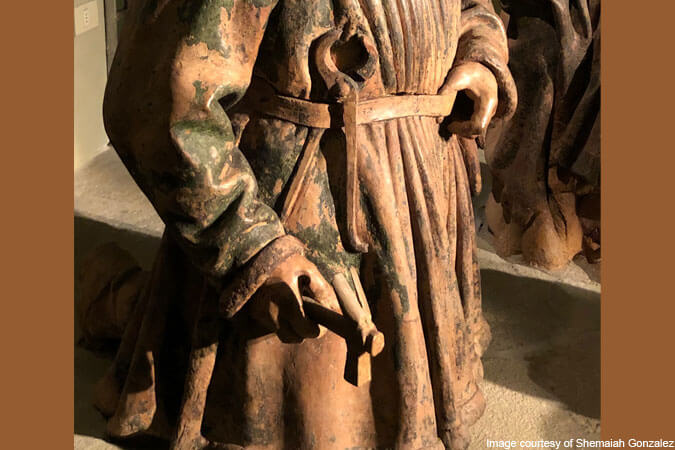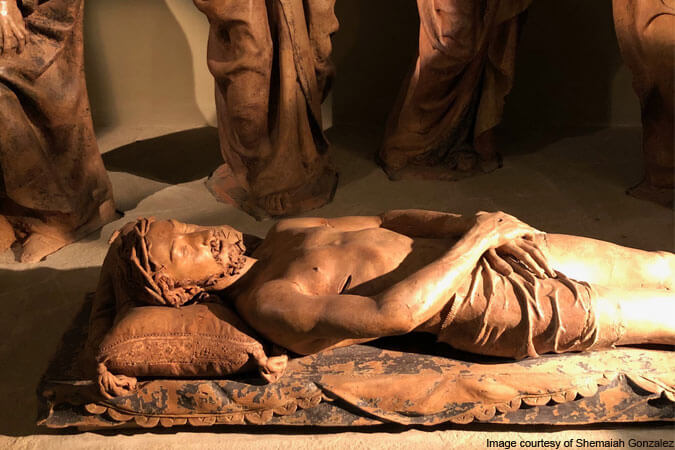 Niccolò dell’Arca’s Mourning over the Dead Christ, often simply called Lamentation, moves us into the depths of Good Friday’s grief. (See a video of this piece of art below the article.) There is no way to prepare for the visceral images of six life-sized terracotta sculptures mourning over Christ’s body. The grief is palpable as viewers find themselves nearly frightened of the masterpiece. This grief is not quiet.
Niccolò dell’Arca’s Mourning over the Dead Christ, often simply called Lamentation, moves us into the depths of Good Friday’s grief. (See a video of this piece of art below the article.) There is no way to prepare for the visceral images of six life-sized terracotta sculptures mourning over Christ’s body. The grief is palpable as viewers find themselves nearly frightened of the masterpiece. This grief is not quiet.
The first figure we encounter is Joseph of Arimathea, the wealthy man who shouldered the responsibility for Christ’s burial. He’s shown holding the hammer and pinchers he used to remove Christ’s body from the Cross. He cannot bear to look at the body of the man he had followed, now empty, lying before him. It is almost as if he were to look, the grief would overwhelm him.
 Next, we see the mother of Apostles James and John. She once asked Christ whether her sons could sit at his side when he became ruler. Now she appears clawing at her own body, as if to afflict injury to mask the pain she feels. Later, she would prepare Christ’s body for burial. We can imagine her tears falling upon his body as she cleansed it.
Next, we see the mother of Apostles James and John. She once asked Christ whether her sons could sit at his side when he became ruler. Now she appears clawing at her own body, as if to afflict injury to mask the pain she feels. Later, she would prepare Christ’s body for burial. We can imagine her tears falling upon his body as she cleansed it.
Then, we notice Christ’s own mother, Mary, the one who gave birth to this child born to die. She was there at the foot of the Cross as he died. Now she stands before his lifeless body, clutching her hands in agony. She holds them against herself as if she is holding in her very heart to prevent it from escaping. But she is, isn’t she? Not only is her child dead, but her Savior.
John, the beloved disciple, stands beside Mary. Even in Christ’s own anguish on the Cross, he showed compassion for his mother and presented John as a new son to care for her. Here John seems unable to comfort his new mother, let alone himself. He stands heartbroken, frozen before the body of his Lord in disbelief.
Next is Mary, wife of Clopas. She is mentioned only once in Scripture. In the Gospel of John, she stands with Mary, the mother of God, at the foot of the Cross. It is assumed that she, too, will prepare the body for burial. Early historian Eusebius of Caesarea held that Clopas was St. Joseph’s brother, making this Mary Christ’s aunt. Here she holds her hands out, as if to shield herself from the horror. Her body pushes backwards; we hear her gasps as she chokes on her sorrow.
 Each figure expresses grief differently, in ways the viewer can identify with, but it is Mary Magdalene who draws our gaze. She is in motion. Mary Magdalene is caught in the moment she runs into the room and sees Christ’s body. You hear her screams and gut-wrenching howls, knowing she will collapse on our Lord’s body in despair. It’s not only anguish but fear. She remembers the last time she felt grief, when she came to Christ in repentance. He had given her hope. Was that all for nothing? She can’t live like that again. None of us can. The alternative is terrifying.
Each figure expresses grief differently, in ways the viewer can identify with, but it is Mary Magdalene who draws our gaze. She is in motion. Mary Magdalene is caught in the moment she runs into the room and sees Christ’s body. You hear her screams and gut-wrenching howls, knowing she will collapse on our Lord’s body in despair. It’s not only anguish but fear. She remembers the last time she felt grief, when she came to Christ in repentance. He had given her hope. Was that all for nothing? She can’t live like that again. None of us can. The alternative is terrifying.
Lamentation invites us into the raw emotion of the day when all hope seemed lost. The day when it seemed the darkness overcame the light. On Good Friday, sit before Christ’s body, and feel the full weight of grief, not only of that day over 2,000 years ago, but in imagining our own lives without Christ.
Without that weight of grief, we cannot begin to fathom the glory that awaits us.

Grief – awakens the core of our being. Well written.Thanks.
Thank you. I only wish the video was longer. The sculptures are so powerful and your reflection so poignant – especially about the insights of grief, hope and the promise of the glory yet to come.
Thank you, I have often meditated on the death of Christ and this has helped me to consider it more personally